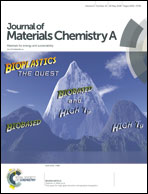Evaluation of energy loss at Sn anodes based on phase transition behaviors and formation of electrically resistive phases of Na–Sn batteries†
Abstract
Despite their large theoretical capacity and fast-charge capability, Sn anodes suffer from large energy loss when used in Na-ion batteries and the underlying physics is not yet fully understood. We developed a thermodynamic model that can replicate voltage curves associated with battery cycles by incorporating the detailed phase transition behaviors and the associated resistivity changes of the Na–Sn system at various applied voltages. The present study is the first attempt to reveal the fundamental physics behind the shape of the voltage curves of Na–Sn batteries. The developed model allows the elucidation of the structural origin of the large energy loss at the Sn anode. We observed that the simultaneous action of the multiple phase transition behaviors and the formation of electrically resistive phases is responsible for the large energy loss at the Sn anode. This work also provides useful insight into the design of attractive anode materials for realizing batteries with high energy efficiency suitable for future electric vehicles and energy storage systems.



 Please wait while we load your content...
Please wait while we load your content...